How to feed your poultry at every life stage
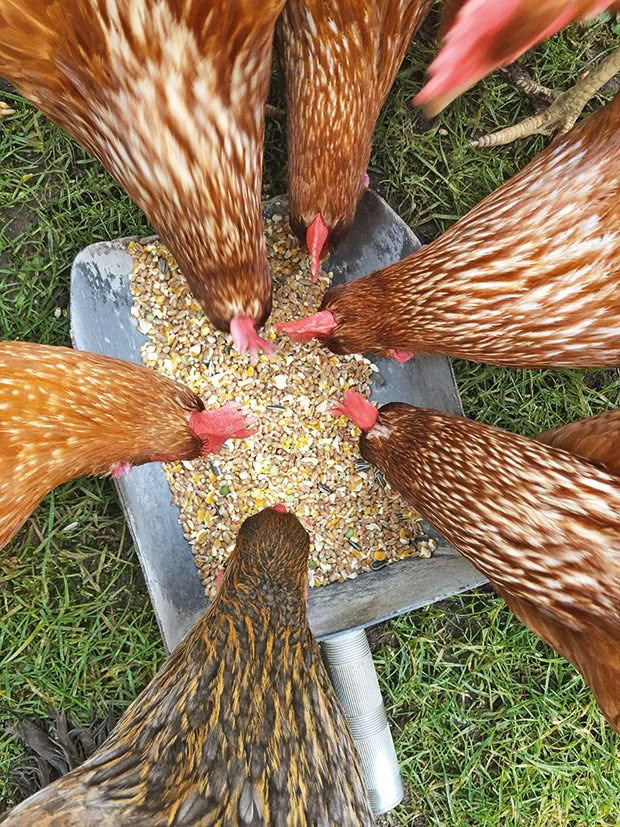
The happy, healthy chicken diets you need to feed your poultry for every age.
Words: Sue Clarke
Poultry require different diets depending on their age. The most important thing you can do to grow healthy, productive poultry is feed them right.
Every chick hatches with a pre-determined level of genetic potential in terms of growth rate, fertility, egg production, meat production, feathering, the robustness of its immune system, and so on.
Whether it reaches and maintains its potential is dependent on the nutrition it receives. There are six basic stages in the life of a chicken, where essential nutrient requirements differ.
Failure to provide the correct nutrients may compromise the bird’s health, development, and lifespan. Poultry will tolerate an unbalanced diet, as they would in the wild, where they’re subject to the seasons and a changing environment.
However, the fluctuations in the availability of various plants, seeds, and insect life throughout the year have consequences:
– chicks hatching too late or too early miss out on crucial nutrients and can die before reaching maturity;
– a hard season may kill off the very young, very old or compromised.
In captivity, poultry is dependant on us. Even birds in the most idyllic free-range situation will rely on their owners for the bulk of their nutrition.
Confinement, or a lack of diversity in a large range, denies poultry access to the seeds, fruits, insects, small mammals, and other food sources which would make up a nutritious diet in their native habitat.
The main differences between the nutrient requirements for each life stage are the amounts of:
– protein
– essential amino acids
– energy, eg fats, carbohydrates
– minerals and vitamins, especially for birds aged 0-25 weeks.
Back in the days before commercially- made feed was available, a poultry keeper would make their own from a range of easily available ingredients. It was always a matter of trial and error as to how much of each ingredient birds needed to thrive.
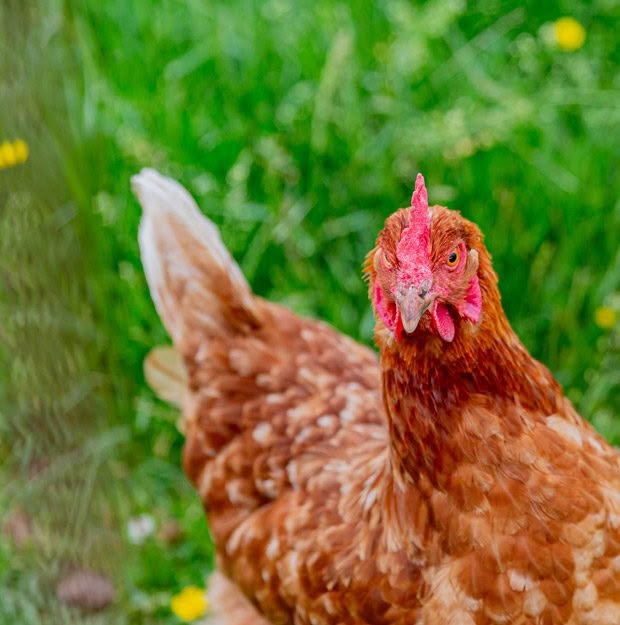
In the 1940s and 1950s, commercially formulated poultry feed became available. Todays feeds are based on decades of scientific research that have defined the needs of poultry throughout their lives.
A balanced, nutritious commercial feed is made according to specifications prescribed by an avian nutritionist. It will use good quality ingredients and be fed in the correct quantities to the correct age group. Using these feeds is the easiest, most economical way to feed poultry, even for very experienced owners.
There are always factors which influence whether a bird gets the nutrition it needs. Some you can control, others you can’t.
These include:
– environment
– time of year
– quantity of feed
– feeding space
– breeds
– mixed-age groups
Generally, if you allow your flock unlimited access to the correct commercial feed for their age, you’ll overcome most of these limitations.
One of the most common mistakes people make is restricting the amount of feed they put out, especially during late summer-winter when birds aren’t laying. It can be tempting to save money this way, but poultry needs just as much nutrition, often more, to cope with colder temperatures and the stress of moulting and re-feathering. If they don’t get it, they’re going to struggle to be as productive or as robust as birds that do.
You can also have an issue when you have a flock of young birds of different ages and breeds. The bigger, older, faster birds will get the most feed. There may not be enough left over for the smaller, slower chicks to develop normally.
People think a free-range, whole grains and kitchen scraps may help. But this food doesn’t contain the essential nutrients that poultry need for good health, let alone what a chick requires for proper growth.
HOW TO FEED YOUR POULTRY AT EVERY LIFE STAGE
Chick, 0-6 weeks
Feed: Chick Starter
18%+ protein, or higher for meat birds, turkeys, quail, pheasants
1% (or less) calcium
As soon as it hatches and is dry, a chick will instinctively look for food. They can survive up to 48 hours without food or water thanks to the remains of the yolk sac inside them, but it’s best to encourage drinking and eating as soon as possible.
Chicks are naturally attracted to anything shiny or things which stand out in colour from the background. A mother hen will cluck and pick at things to encourage chicks to eat.
If you’re rearing chicks artificially, you can tap the feed or water dish. Add glucose to their water, to help any weaker chicks get the energy they need to hunt out food. The little crop (on the front of the chest) should swell to marble size with food and water within 24 hours of eating, indicating they have figured things out.
TIP: A good quality chick starter feed will contain a range of amino acids that meet their needs. Two important ones are methionine and lysine. Some manufacturers will include levels on the bag. Methionine and lysine are sourced from animal protein, or manufacturers add synthetic versions to a vegetable-based product.
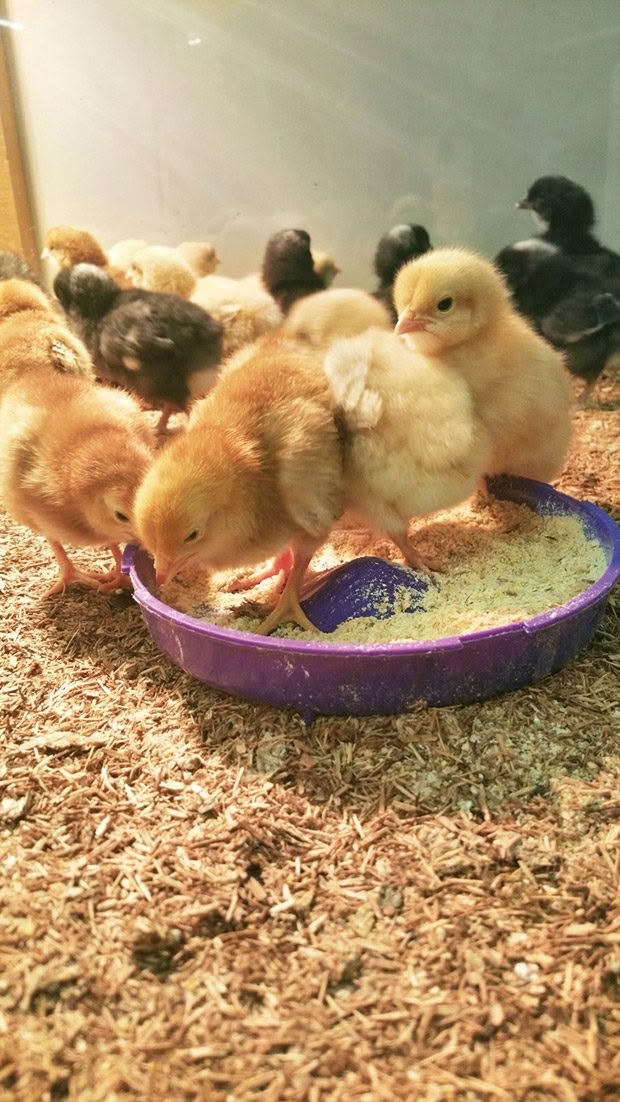
If feed lacks these amino acids, you may see behavioural problems such as feather pecking, flightiness, and cannibalism. Most chick starter products will also contain low doses of anticoccidial drugs. These are to help prevent outbreaks of coccidiosis, a devastating disease caused by coccidia parasites in the gastrointestinal tract. They work best prophylactically – given ahead of a potential infection, instead of after – preventing replication and growth.
There are several different species of avian coccidia, and they’re quite common. They cause diseases which can develop quickly and are one of the biggest killers of young chicks. If a chick survives, there’ll be permanent damage to its intestinal tract, which may affect lifespan and production. Anticoccidials can be toxic to other livestock, especially dogs, horses, and in some cases turkeys.
TIP: Always keep starter feed in a secure storage container. Don’t feed it to laying hens as anticoccidials have an egg withholding period. Some starter feeds may also include oils, such as oregano. These have some anti-bacterial and anti-parasitic properties, but not enough to prevent an outbreak if coccidia levels are high. After 5-6 weeks, chicks begin to develop their immune system and are less at risk.
Grower, 6-17 weeks
Feed: Grower or Developer
16.5% protein (or close to this)
1% (or less) calcium
During ‘teenage-hood’, a bird develops its first set of feathers and a fully developed skeleton. Any maternal antibodies will have gone, and it will be developing its immune system. Make a gradual change from starter to grower (or developer) when chicks are 5-6 weeks old.
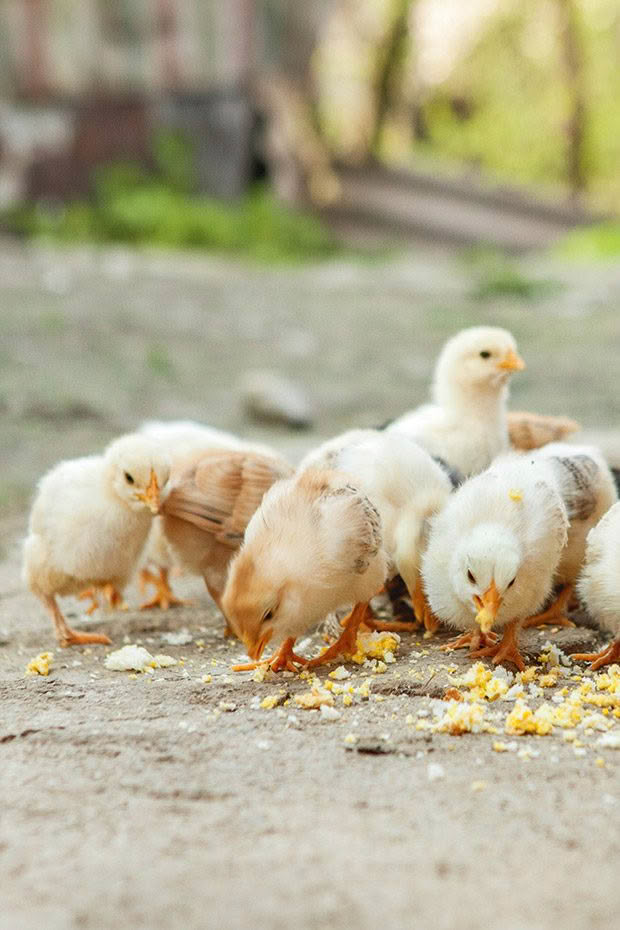
Grower doesn’t contain a coccidiostat. It’s important to reduce starter levels and increase grower levels over a week or so, giving their immune system time to adjust as the level of medication reduces.
TIP: Grower is lower in protein (and so cheaper to buy). It’s also an excellent option to feed to adult non-laying birds, such as moulting hens, roosters, or hens that have stopped laying.
Pre-adult, 18-25 weeks
Feed: Layer (for Shaver/Hyline birds 16.5%+ protein, 3.5% calcium)
mix of Grower and Layer for heavy, slower-growing breeds
If all your chicks are the same age, and you know the expected date of the start of lay (eg, 18-20 weeks in Hyline and Shaver hybrids), then you can slowly transition from grower to layer feed from 16 weeks. Start later in slow-growing, heavy breeds, which may not start laying until aged 25 weeks, or older. Layer feed is higher in protein and calcium.
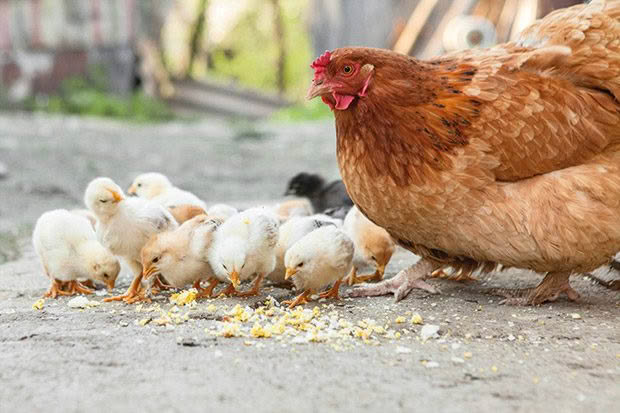
You can also add a vitamin/mineral supplement, especially if hens are producing fertile eggs. Use a 50-50 mix of good quality, balanced layer, and the grower feed for two weeks or so before you expect them to start laying.
TIP: It’s important not to start doing this earlier than 16 weeks as layer feed is high in calcium which can cause permanent kidney damage in younger birds. Provide a separate dish of oyster shell grit so any faster-maturing pullets can take extra. Don’t mix it into feed.
Adult, 25 weeks – first moult, and subsequent laying seasons
Feed: Layer
16.5%+ protein
3.5%+ calcium
Commercial laying hybrids will usually start laying at 18 weeks. If conditions are favourable, they can lay right through their first autumn and winter, not moulting (or stopping laying) until they are 18 months old.
Heritage breeds hatched in July or August will start to lay in December-January. They might lay over their first winter but will almost certainly moult before they’re 12 months old. You need to feed a balanced, quality layer feed with at least 16.5% protein and 3.5% calcium for Shaver and Hyline hybrids, bantams, and light heritage breeds.
Heavy heritage breeds can do well on lower protein (cheaper) feed but will eat more. You may need to provide extra calcium in a separate dish for high-producing birds, or when commercial feed is only part of the total diet. Roosters and hens expected to produce fertile eggs may need supplementary vitamins and minerals for top fertility and chick development. Add these to the water supply.
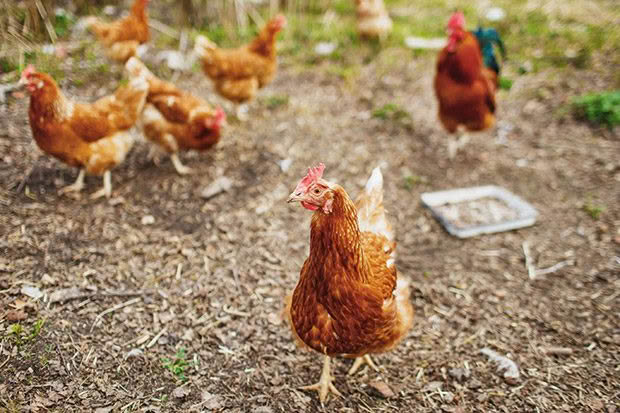
Laying hens need free access, 24 hours a day, to a nutritious feed with the correct energy and protein levels. If it’s only part of their diet, they will try to make up the shortfall with whatever else they can find. But scraps and what they’ll find free-ranging are not as nutritious and may compromise their production (or growth in the case of meat birds).
TIP: Give poultry the commercial feed at the start of the day, so their basic nutritional needs are met. If you feed it at the end of the day, they’ll fill their crop with nutrient-poor scraps and vegetables, and won’t have room for it. When people ask for help with their poultry, it’s my experience that often their birds are on restricted amounts of a commercial feed.
There’s often too much reliance on kitchen scraps, whole grains, grass, or (often non-existent) insects. Ideally, scraps and whole grains should be limited to 10g per bird per day, or around 13-15% of a bird’s diet. The majority should be a commercial feed.
Moulting
Feed: Layer (16.5%+) or meatbird crumbles (20%)
All adult poultry moult, replacing a full set of feathers, once a year. For most birds, it happens as the days get shorter and the temperature cools in late summer. By the start of winter, they have a new set of feathers for warmth. Their bodies are also replenished, ready to start the new egg-laying season when the days get longer in July.
Moulting at other times of the year, either fully or partially, is usually a sign of stress, such as a change of environment, illness, infection, or bullying. Moulting varies between birds. Some drop almost every feather overnight and show a mass of wax-encased ‘pin feathers’. Others do it gradually, some replacing just a few feathers at a time. You may not notice they’ve done it unless you examine them carefully.
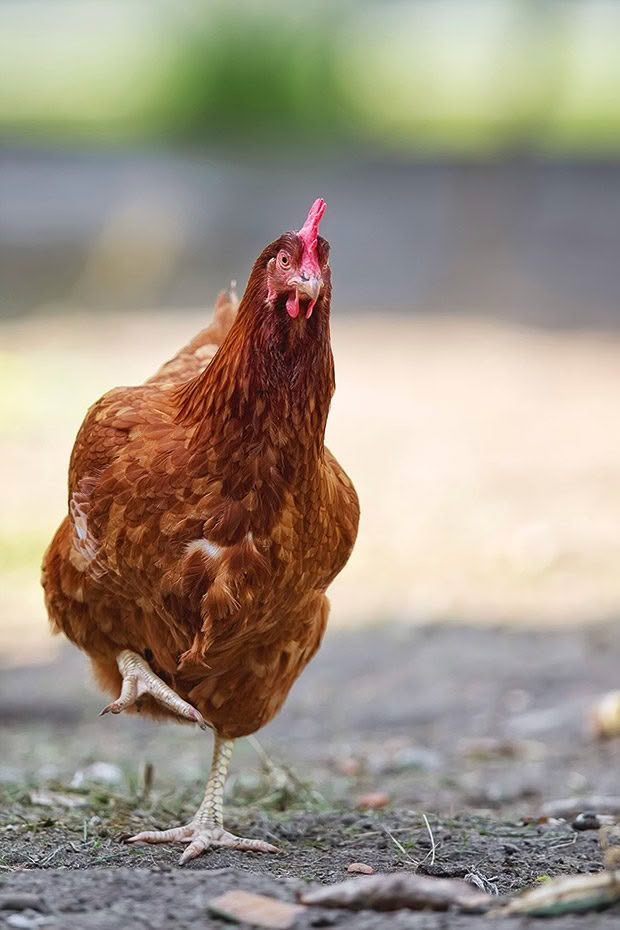
Generally, breeders find the best layers are the ones that drop their feathers quickly and look almost bald. Shavers and Hylines often look almost naked, still putting their energy into egg-laying, not feathers. Their exposed skin thickens and reddens, which makes it look sore or sunburnt (this isn’t the case).
TIP: Birds need a high-protein diet to grow feathers. Economical options include a non-medicated starter feed, eg meatbird crumble (20%). You could continue with layer feed and add additional protein such as meat, good quality dog roll (check the label for a high protein option) or meat meal. Feathers are 80-85% protein. It’s not that digestible, but don’t be surprised if birds eat them.
Retirement
Feed: Grower (16%) or meatbird crumbles (20%)
As birds reach the end of their productive lives, it’s important to keep them fit and healthy for a happy retirement. Most will do quite well on grower. Birds which are very old and not foraging may do better on a higher protein meatbird crumble.
However, if they are part of a flock which has laying hens in it, they can stay on the layer ration. The calcium level will be too high, but it will be excreted.
SUE’S SEVEN TOP TIPS
1. Do some research on what brands of food are available in your area. Compare the ingredients, especially protein, amino acid, and calcium levels.
2. Feed the recommended quantities, typically 120-130g a day for 2kg Shaver or Hyline hybrids, up to 150-160g per day for heavy heritage breeds.
3. If you have a mixed flock, consider keeping young birds separate from older ones. Their nutritional requirements are very different, and their needs will be compromised.
4. The wrong feed can have deadly consequences, such as feeding high calcium layer feed to young chicks. They won’t die immediately, but the kidney damage can be fatal as they mature and come under stress, such as when they start laying.
5. Feeding food too low in protein and energy can increase appetite for bulky foods such as bread, pasta, and vegetables. This can lead to fatal fatty deposits in the liver.
6. Too much protein can lead to fewer, but larger eggs, leading to prolapse of the oviduct, or an egg that can’t get out.
7. General multi-feed pellets are sometimes advertised to suit ‘all types of stock’ but aren’t suitable for poultry.
6 LIFE STAGES OF POULTRY
Chick: 0-6 weeks
Grower (teenager): 7-17 weeks
Pre-adult: 18-24 weeks
Adult: 25 weeks – 18 months or so (first moult)
Moulting: Annually, 2-3 months (usually late summer)
Retirement: 3-5 years, or once egg production is minimal or stops
MORE HERE
Love this story? Subscribe now!
 This article first appeared in NZ Lifestyle Block Magazine.
This article first appeared in NZ Lifestyle Block Magazine.
